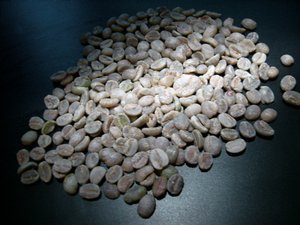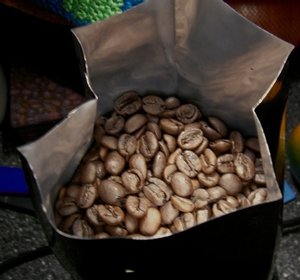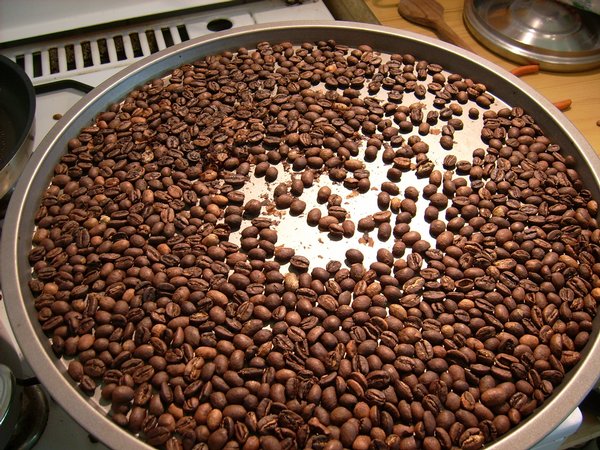Einträge zum Thema Roasting
Samstag, 12. November 2011
Enjoying the fruits ...
This is a first for me: enjoying the fruits of my very own labour as a professional coffee roaster. A bit long in the making, but finally there:
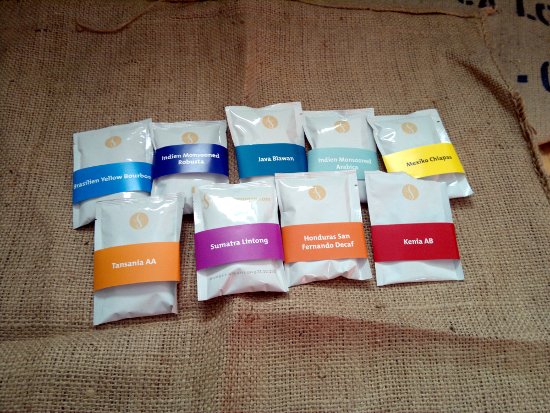
Sure, that Kenyan I'm sipping right now. What else!
Want some? Only within our advent calendar, for now. Watch our Blog (there might be a post about my roasting experiences or so in the next few days, plus Jessica writes about designing the calendar) and subscribe to our newsletter to be notified for updates.,
Sorry for the commercial break, back to normal mode now. I'm just being a little proud here!
Mittwoch, 12. Oktober 2011
Roaster for sonntagmorgen.com
Freitag, 16. September 2011
Sneak peak!
This (sorry, german only) is a sneak peak into my future profession. Expect details tomorroy. Stay tuned!
Dienstag, 16. August 2011
Professionalism
This was a long time in the making, and it's becoming more real every day now and I really positively absolutly cannot hold this back any longer: I'm going to be a professional coffee roaster, or 'Head Roaster' in the very near future.
There, it's out of the box - I've annoyed only my friends with this long enough now, time to annoy the readers (are there?) of this blog as well! I really am so happy about it that I just can't find the proper words to describe it.
It's fulfilling a dream I've had ever since I seriously got into coffee, which must have been around 2004-something.
So what does this mean to me?
Firstly, I'll do professionally what I do in private anyway - roast coffee, cup, enjoy, brew. Well, and then selling it as well, that'd be new! It's just not the 200g-batch roaster anymore, but likely a 12Kg batch roaster. There'll be loads of learning for sure roasting 12Kg batches, just as there was with the last few hundred roasts of 200g batches. In the end, I want to produce (And consume! And sell!) really good coffee, and being able to do this in a commercial scale in a microroastery is really exciting! Though I fear that screwing up a 12Kg roast will be much more costly and more people will be mad at me than screwing up a 200g roast, where it's just me and my SO ;)
Secondly, I am not so sure wether I can split my personality between coffee-blogging-and-forum-posting-me and coffee-blogging-and-forum-posting-commercial-roaster-me - I just don't see there being much of a difference. I still like to promote manual brewing, good coffee and everything that belongs to it. We'll see how that works out, so for now just keep in mind that I'm also going to sell you coffee if you don't look too carefully. If it gets too annoying, feel free to slap me for it!
I'll talk about the details of how, when, what, where and why in future posts on here, on TMC or the german Kaffee-netz. If you follow my twitter stream, you might already have an idea about the direction this all takes. For the moment, we struggle with the german beaurocracy and would have been up and running already if I hadn't been so naive as to believe we'd pull this without month-long formal propositions to the city administration and stuff like that.
Early september, we'll hopefully receive a pre-decree telling us either to go away (nay!) or to proceed with the real request (yay!) for the permit to open a roastery at that specific place. And this already is the simplified variant of requesting such things, the 80's must have been horrible for opening a coffee roastery!
So, all in all not such a big difference to what I do anyway, except the formal stuff (city administration) and having a much bigger lab than just the kitchen to play with.
Now that will be an interesting ride!
Very excited to work with a few new and old friends together on all this!
Mittwoch, 9. März 2011
The Quest M3
This is a repost of my description of the Quest M3 on toomuchcoffee.com.
I've had it a little over three months now and have done somewhere inbetween 75 to 150 roasts with it (I didn't log every roast in the beginning), so I feel quite confident handling it right now. First some pics:
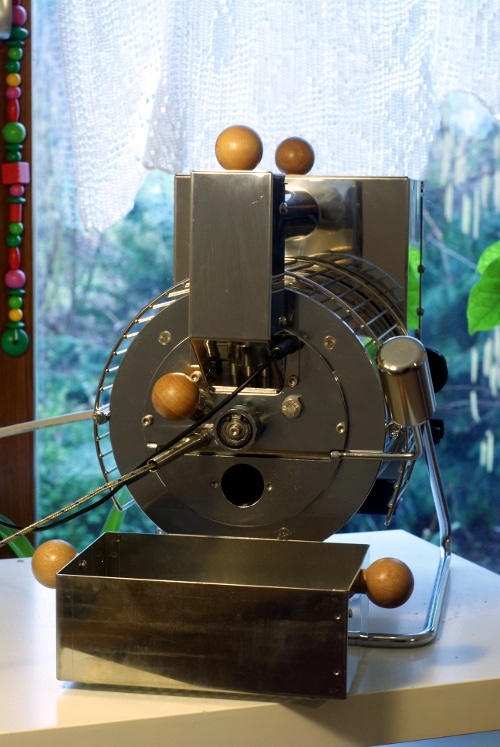
As you might have guessed if you saw previous pictures from me, it was not me who took them, but a good friend who's having as much fun taking pictures as I have roasting with the Quest. It's a nifty little machine, consists mainly of stainless steel and weighs about 12kg. It is rated with 1050W at 220V, and with our ~230V in the house it will happily draw 1200W if I'm not cautious with the knob. Specs also say it can handle 100g-300g loads of coffee, I've only tried 150g-250g for the moment and have been very successful with it. The controls are slightly steampunky:
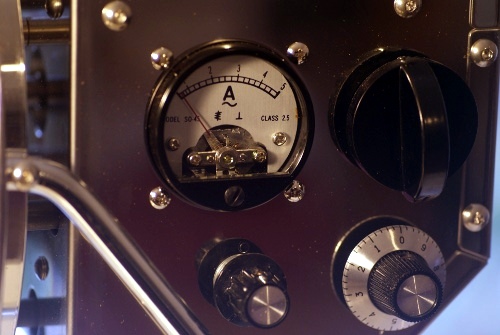
From top left to bottom right: Amperemeter, main switch (which happens to be a 45-minute kitchen clock), regulator for the power to the heating elements, regulator for the fan.
Be careful!
To make it crystal clear: this roaster has no safety device built in whatsoever besides the main switch, which can be set to 45 minutes max, and a circuit breaker. If you manually prolong the timer (by e.g. giving it another 45 minutes shortly before it runs out), you can easily set your house on fire or something like that. A thing to keep in mind while operating this^Wany roaster.
Even with a 250g load, my Quest seldomly needs more power than 1000W (which would be around the 4.33A mark on the meter). Throughout a 200g roast, the power it draws for me is around the 750-800W mark, so imagine what would happen if you give it the full 1200W and go away during the roast! Remember, no safety device?
The threads on home-barista were a tremendious help for me in quickly learning how to operate this roaster. I've had my share of undrinkable batches, but all in all I threw away less than 2 KG.
Here's a picture mid-roast (near the end):
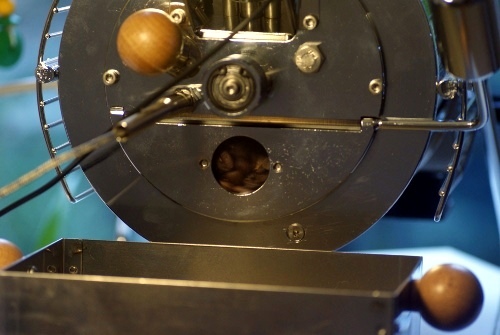
And dumping the beans:
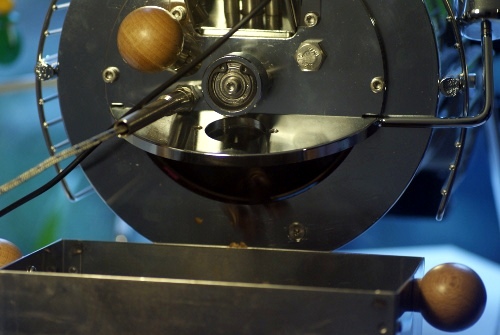
The result:
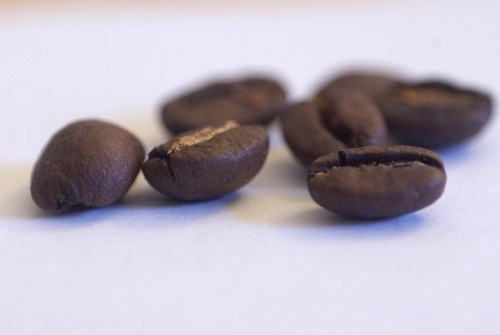
And the Quest's ingenious effortless cooling mechanism, which gets the temperature of the beans down to room-temperature within three minutes with 250g batches, even if they were into 2nd crack:
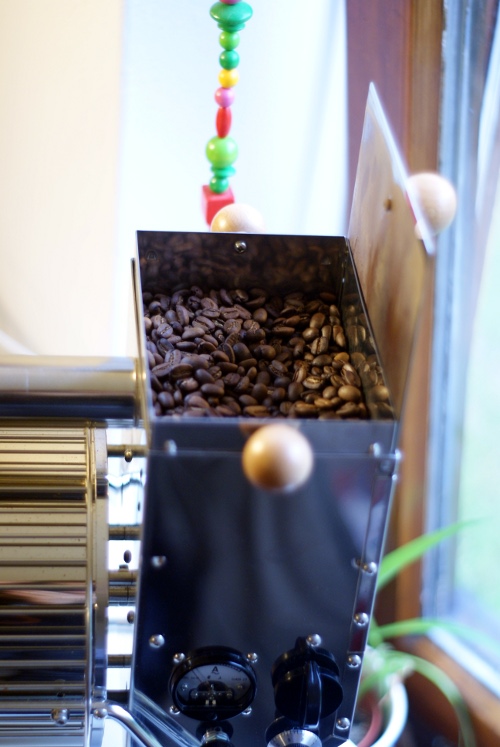
Does this read like an advertisement this far? Sorry, I just like my Quest! Might also have to do with myself having to justify the amount of cash sent over to Taiwan for it. But there are some downsides as well.
Cleaning
You need to clean it. This is how the space around the drum looks like after four roasts with less chaffy beans:
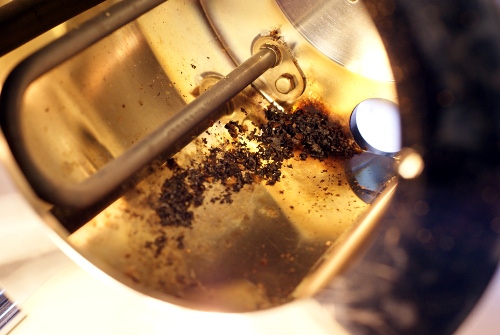
Guess how the burned chaff smells? I once forgot my allen key somewhere (all user-servicable parts are allen screws, and the Quest came delivered with a matching allen key for them) and did 15 roasts without cleaning this space. I'm quite happy that it didn't suddenly explode besides me! Surprised
Cleaning 2:
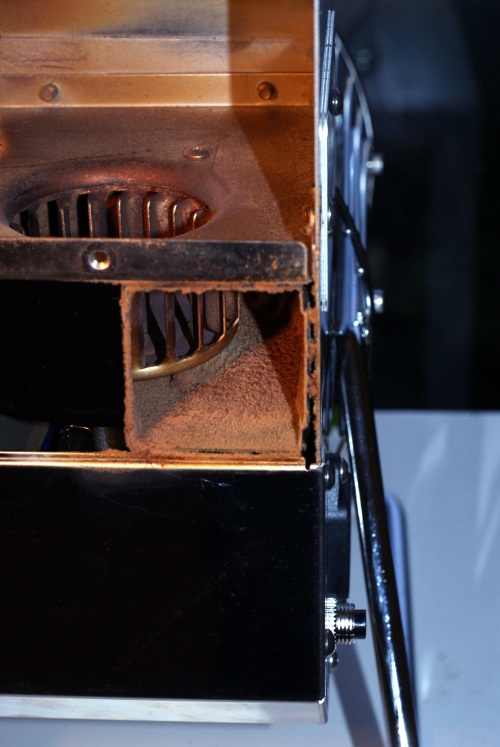
This was how the Quests exhaust looked after my first three months of using it. Maybe I should have cleaned this part earlier! To get to the exhaust, you need a slightly smaller allen key which didn't came with the Quest, so I suspect this is the not-user-serviceable area. You need to clean it every ~100 roasts, anyway, or it will gunk up.
Okay okay, this is probably not a downside at all - I guess you have to do regular maintenance on every other roaster too. I just didn't realize how much gunk would build up everywhere until I opened the case! With my stove-top roaster, the gunk would simply fly around the kitchen, ready for the vacuum cleaner to fetch.
Now for the worst part.
Electrics
If you're an electrician, you probably do not want to see this. I am not, so I don't really know, but it looks quite ... not so CE-worthy to me:
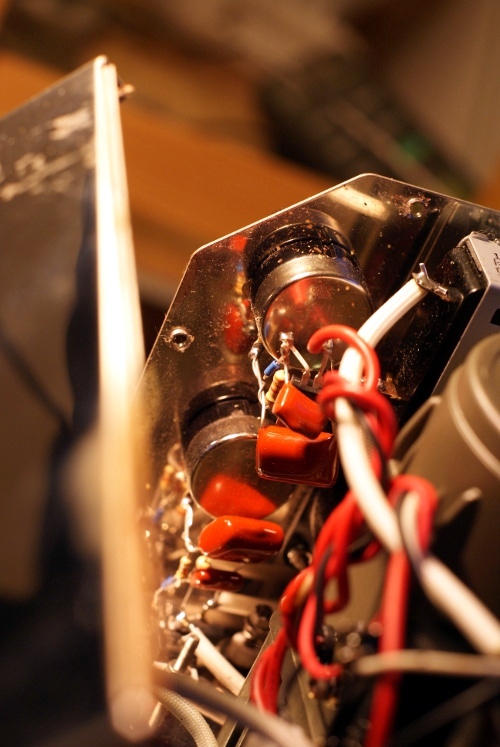
The round plates are the backsides of the two knobs.
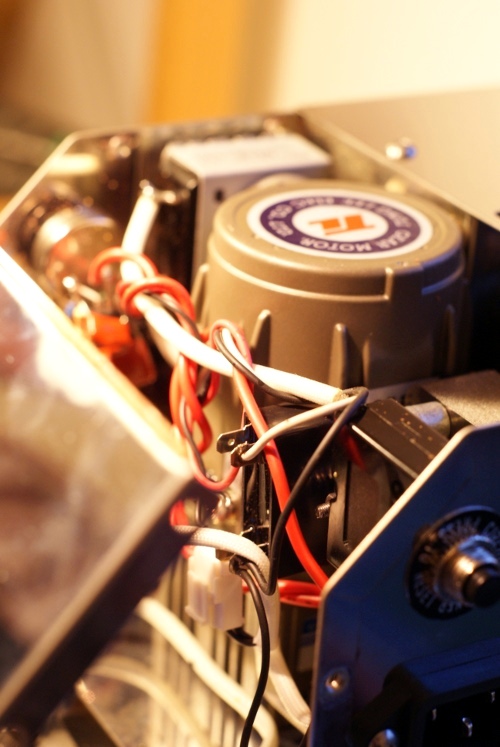
Though unisolated, the electricts are quite immovable within the case plus it's earthed, so I don't fear immediate death. I'm just quite happy that I didn't know this before the purchase, as it might have put me off! Comments from electronics-savy people would be very much appreciated here.
The Good
Enough of the bad and back to the good:
This is a Rwandan bean (don't know the specifics, but asides from the occasional potatoy-bag it's very smooth and tasty), roasted just until the end of 1st crack:

Thanks to the thermocouples supplied by the Quests' manufacturer and a not-so-cheapish datalogger and the Artisan project, I can record the profiles:
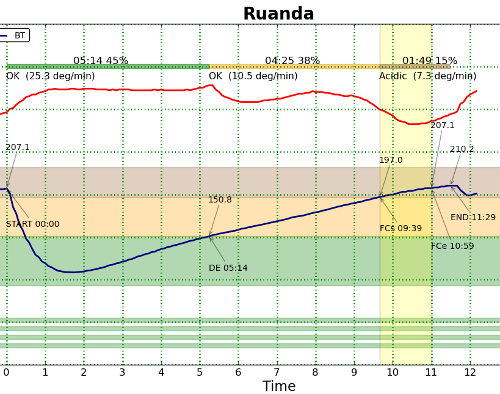
The upper red line is the temperature measured between the outer casing and the drum, so it should approximate the amount of energy being applied from the heating elements. Minus the airflow - it would be really helpful to automate logging of changes to the airflow and heating power, as airflow changes have a direct impact on the measured temperature outside the drum. The blue line is the temperature of the bean mass probe, first crack happened during the yellow marked area. I haven't tasted this specific roast before, but I know that the bean tastes very good.
We also did a little animation, taking a photo through the sightglass ca. every 30 seconds. Watch the slideshow in full-hd here - It's an OGG Theora video, so it should theoretically work with Firefox and Chrome, but probably not in Safari and IE.
The tryer
Oh and have you noticed the tryer? It's so cute! Depending on the bean size, it catches 3-7 beans when you pull it out. I'll probably make a new handle for it, as it's a little thick and brings the fingers dangerously close the very hot exhaust in front of the front plate!
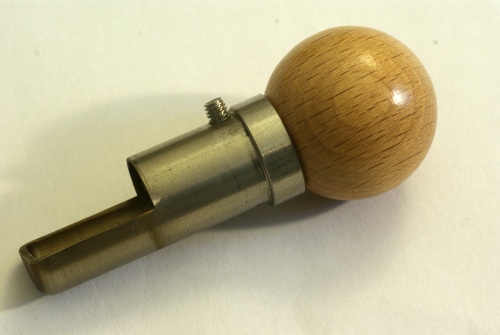
Oh and did I mention the best thing of all? Even though it's batch capacity is somewhere around 200-250g for me, you can roast back-to-back. My longest roast session was 10 roasts in a row, took me a little over two and a half hours and left me quite caffeinated/hyperventilating, as I do not have such a nice exhaust hood as Bruce has. Roasting indoors is fun, but with only the windows open it gets cold and smokey after 2-3 roasts.
Freitag, 5. September 2008
Panama Hacienda La Esmeralda Especial Batch 5
It took me that long to write up something on that special coffee. No apologies for that, as was quite busy (and still am) at the moment, and this sat long enough in the pipeline to be ready now.
So. What a name for a coffee. But it's good to be precise on this one - it allows poeple to identify the exact batch of coffee I'm talking about. That doesn't happen too often even in the special specialty coffee world, where direct trade models are being established, importers buy based on quality and building long-term relations with the farmers, roasters roast to perfection with each bean and blend having it's own roasting profile. So this is the batch I received from Walter's Kaffeespezialität, and I finally decided to write what I think about it after a friendly nag from a friend (I wrote this quite a while ago but only now managed to find the time to overlook and publish it).
The setting of this tasting was quite a thing for me. At Squaremilecoffee, roasted by Anette Moldvaer, together with a good friend that I've made through toomuchcoffee.com, side by side with a Cup of Excellence from Costa Rica, El Portillo if I remember correctly, and an unnamed Rwandan sample if memory servers me right.
It was a blind cupping, that means Anette arranged the coffees for us, three cups of each, without us knowing what was what. But to be frank, it was outright clear from the first sip which coffee was the Esmeralda, just because it was so different from what I was used to. (Now this is the point where I stopped writing some two months ago. Great.)
I could grasp why people are paying so much money for coffee from this farm. It's different. It's one of these showcase coffees that Steve talked about in the latest common grind podcast. But it's more than that: it is actually very, very, very, very, oh yes very enjoyable. The mouthfeel was more tee-y than any coffee I'd encountered before, light on body in a good way, the smell was very peachy as was the taste. Very sweet, too. Somehow, the taste reminded me of that lovely peach iced tea I used to drink ten years ago. Thouroughly enjoyable. It's a shame that I didn't make more notes back then, but I will have the chance to cup it again, as I still have around a hundred gram left that really need to be roasted soon. I just don't know yet how, as always!
In the eternal department of new toys my newest addition: Bestest of cupping spoons ever invented (not that I'd know ...)
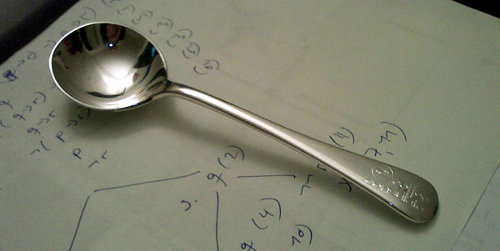 Thank you Dr. Schwarz, it's a blessing and such a lovely tool!
Thank you Dr. Schwarz, it's a blessing and such a lovely tool!
Dienstag, 15. Januar 2008
prepare to compete
The competition is now three weeks ahead and I'm getting nervous. Last friday, David and I had a little training evening at Edzard's MuffinMann. He impressed me with his stunning and well-thought-of signature beverage. With a few small changes it'll be really great!
That evening also tought me that I'm too unprepared yet. No concept, only ideas floating around - at least I do have a working (though very risky) signature beverage! The next three weeks will be weeks of intense training (as intense as I can do at home).
I am very glad that Kaffeespezialität's Dr. Walter Charzewski is willing to roast the coffee for me. One of the two coffees I'll use is already set - if you know me, you'll have no real difficulties to guess what's it. For the other, I'll expect a pack of samples within a few days for me to experiment with - I have a general idea, but not made up my mind yet.
If you don't know where to order your next batch from, you really should try Walter's coffee. If you know already, heck, do so regardless ;), as he is one of the very few roasters I know that stock real quality coffee, and from what I taste in the cup he does put real effort and care into getting the best out of the bean.
Matari again
I talked about the Yemen Matari before. Three days ago, did another batch - after talking to Walter about my homeroasting methods - and it turns out to be much much better than on my last try. I still can taste it after finishing the cup half an hour ago, and it sit's really nice there on the back of my tongue. I get very nice wooden notes from it, though I do like the roasted wood that I got from Walter's roast more. My homeroast is still not as good as Walter's (of course!), but the race is getting closer (as in - only 100 miles behind, not 1000). Stunning coffee.Am I a pro barista?
On sunday, I did my first video shooting and cutting (well Jessica shoot, I cut) - see here (or here for the bigger flash variant). This was for a german 'home-latte-art-contest', where you can win a trip to Costa Rica. It's not for people working in gastronomy, but home users, so called amateurs (whom I believe most of are better at producing good coffee than many so-called pros are - but that's an entirely different thing). So here's the question:What am I?
I didn't work in gastronomy since August '07, and my work in the Café was a side job for nearly two years. Can I call myself a Pro Barista only because of having had a side job in a Café? Or because I competed last year in the german Baristachampionships and placed 11th?
Can I call myself an Amateur Barista because I read TMC all day long, have nifty (though not pricey!) equipment at home, roast for my pleasure and love what I'm doing at home? All I do coffee-wise happens in my kitchen currently, as you can see on the video. And it happens mostly for my own pleasure. And I pay retail prices, not bulk.
It'll be interesting to see what comes out of this home-latte-art-contest. Currently, I'm the only entrant. I hope that changes, though, but I do of course also hope I won't be disqualified and win the journey. I mean - hey come on - a trip to Costa Rica! :)
Samstag, 5. Januar 2008
Recent coffees
I've been digging more into homeroasting the past few weeks and am amazed that I constantly learn new things, new tastes and surprising facts. For example the El Salvador Finca La Fany: I've had it quite a while ago when I was still using the old Gaggia Coffee and MDF grinder, and I was totally unable to pour a shot from it that was at least drinkable. Medium dark roasted back then, all I got was citric acid on my tongue (that's how it felt like). Based on the taste descriptions, I ordered some again and roasted it myself (into 2nd crack, with heavy ventilating to get the smoke off the beans, roast time around 19 minutes (a tad too long I believe)). And this proved to be another of these wow-coffees on my LaCimbali: Very tasty, creamy with a great mouthfeel, a little citrus (I tried it a bit too early after the roast) and very sweet. Yummy. A very welcome change to the Yemen Matari I've had very much of - the Matari is such a heavy coffee that you get tired of it very soon (at least for the late-afternoon drinks).
On a completely unrelated note, I love this picture my dad took on what would have been the most beautiful day of the year in decembre 2007:

I've also got a bag of my last years competition blend and I must say I still quite like it (when it's a few weeks old that is - too fresh, as it was during competition, it's way tough stuff, too old it's just boring). Not the kind of coffee I'd drink every day (it's a tad bit tough and unbalanced for that), though in milk drink it shines for me.
Before christmas I had the wonderful opportunity to roast a batch of Costa Rica CoE Libano (from Walter) on a Probat sample roaster - Thanks Mario! - but I wasn't very satisfied with the results in the cup. Probably it roasted too long (there seems to be a pattern here with me), although just into 2nd crack (another pattern?). I put the rest of the batch in the grinder and lucky as I am hit the grind spot-on for a very very very lovely espresso. I'd love to experiment more with this bean, there seems to be a lot of potential for great coffee and espresso, though I fear with my home-roasting device all I can experiment is a trial-and-error kind of thing - I can't really speak of reproduceability right now. Maybe that will change in the future - who knows? ;)
If you've got this far - thanks for reading! I'd love to know who actually reads my blog. Please, leave a comment!
Samstag, 24. November 2007
Yemen Matari Homeroast
The bag of Matari was just finished too fast (as always). Everybody liked it, it's a stunning coffee, especially if it's roasted just so well. So there I went roasting up a batch on my own: I hadn't done much roasting in the last weeks (mainly because I had no greens left) so this was my first batch in quite a while, and I was a bit ubercautios. The roast went nicely (as always :)), possibly a bit slow with first crack starting at 16'40 and second around 19'33. I panicked a little as I didn't want to ruin the roast so I stopped it at 19'55. Quite a bit lighter than I'd imagined and than Walter did it.
The taste was ok, though: the Matari was still there, the roasted wood turned a bit down to normal wood, acidity was higher (a little unpleasant; but brewing hotter helped a bit) and generally the taste was muted compared to the real thing (pictured here; the colors are way off but you can see the spots of oil on the bean surface). One advantage the lighter roast had, though: the coffee was now drinkable as normal brewed coffee.
Lesson learned: I need to do more roasts. And I need a proper roaster, but that's a completely different thing ... hooray that I now have a stash of 7kg in the kitchen and a batch of Yirgacheffe roasted that looks just like I wanted it to look!
Mittwoch, 21. November 2007
Yemen Matari
A few days ago I had a small surprise in the post - Walter kindly sent me some of his Yemen Matari Mokka - both roasted and unroasted. Thank you Walter, this is so kind and I still can't believe it.
Before my machine was up to temperature I couldn't wait and aeropress'd a cup of it: don't do that at home kids, this coffee is purely for your espresso machine. Really.
The bag is nearly finished now and I fear I can't replicate these intense nice tastes when I roast it on my own: It makes a very thick syrupy espresso, dense body and a very intensive mouthfeel. Tastes of (don't laugh) toasted wood in syrup-shape, with a nice acidity lingering on the tongue. And it's sweetness reminds me of liquorice - a little weird and very surprising taste experience. Thick, dense, sweet and full of body. It works best for me dosing low, grinding fine and doing a ristretto-type extraction. I can't say much about the aroma (catched a cold and can't really smell, I'm glad that I still can taste).
This coffee is just plain different from everything I've had before and seeing the greens, I see why Steve (and Walter probably too) have problems sourcing a good Yemen - they look a bit ugly and chaffy and not really consistent. But the taste is overwhelming and this Yemen really is fantastic.
Montag, 29. Mai 2006
New Yirgacheffe Crop
In Bern, I collected 4 kilos of green Ethiopian Yirgacheffe (2006 crop), which Steve thankfully brought there for me. Also, I collected a new roaster, which is pretty much the same as this one, only without evil stinking coating on it so that it is actually possible to roast coffee within. And man, it's great and makes fun. And it's considerably easier, because cranking is a lot less exhausting as stirring like mad.
So, these two goods combined, I roasted a batch of Yirgacheffe yesterday (as Steve suggests, just into second crack, took about 15 minutes) and tasted it a few minutes ago, in the frech press. And wow, it's easily the pretty best coffee I ever had in my little french press so far! The first sip was what I expected it to be: a pretty good ethiopian YIrgacheffe. But as the coffee cooled down, the taste got more and more complex, fruity, with more oomph every minute. I love this coffee!
I'm so glad that I've got nearly 4 kilos left of it! Trying it out as an espresso should also be fun. Finally, I'm a full blown home roaster! Yay!
Mittwoch, 10. Mai 2006
I'm lovin' it!
Just finished roasting a batch of Ethiopian Harrar Longberry in a big cooking pot. A bit more uneven than I wanted it to be, but as Steve suggests, I took it into second crack and watched out for the oils. Total roasting time was 23 minutes. Tasting notes to follow on the weekend! And as I'm awaiting guests for friday, I have to go on for another batch of the Kenya Peaberry blend.
Update: Hmm, after drinking a bit of this I think that it's a little bit on the light side. Or maybe it just has such a high acidicy that it's not thaaat drinkable as a single origin ... who nows? Next time I'll try to lower the roast time a bit by rising the heat, and taking it a little bit darker. Fun thing!
Another update: hm. The cup is now cooled down ... like hand-warm ... and there's no acidity left? Strange!
The last update: Above tasting notes are for the Kenyan Rukira, not for the Harrar, in case anyone wonders. D'oh, need more caffeeine today.

